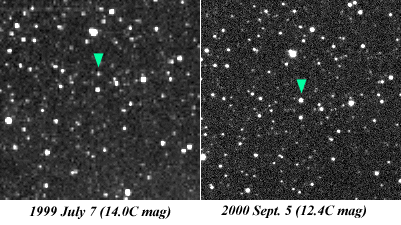Japanese version Home Page Updated on June 20, 2001
June 19, 2001Photometric problem using USNO-A2.0MISAO Project Announce Mail (June 19, 2001) Hello. I am Seiichi Yoshida working on the MISAO project. The USNO-A2.0 is a huge star catalog compiled in the U.S. Naval Observatory, which contains stars down to about 20 mag over the whole sky. It consists of 11 CD-ROMs. The data files are available at: ftp://adc.gsfc.nasa.gov/pub/adc/archives/catalogs/1/1252/usnoa/ Of course, the PIXY System 2 can read this catalog. The USNO-A2.0 editors kindly presented us the CD-ROMs for the MISAO Project activity. We appreciate it very much. Most of the images offered to the MISAO Project recently are examined based on this catalog, the detected stars are matched with the USNO-A2.0 data, then the R.A. and Decl. of the image center, the field of view, etc., are calculated. Because the USNO-A2.0 contains magnitude of faint stars, the CCD observers sometimes estimate the magnitude of their target objects comparing to the magnitude recorded in the USNO-A2.0. The catalog contains the R-band magnitude and B-band magnitude. In general, a CCD camera has a high sensitivity in red band, so the observers estimate the magnitude comparing to the USNO-A2.0 R-band magnitude. However, the magnitude recorded in the USNO-A2.0 has large error and it is hard to determine the accurate magnitude. Sometimes the result becomes very wrong, 2 mag or more shifted from the true magnitude. One example of such cases is introduced in the following MISAO Project web page. Photometric problem using USNO-A2.0 The sample image in this page is taken by KenIchi Kadota, which covers the field around R.A. 21 hour, Decl. +44 deg. The page shows the unfiltered CCD image and the star chart of the same field where the USNO-A2.0 stars are plotted in R magnitude. At a first glance, we can see that many stars are lacked in the USNO-A2.0 in this field. In addition, it is hard to make match between the stars on the image and stars on the chart. We can make match easily between only a few very bright stars. As this example shows, it is hard to make match between a CCD image and a star chart based on the USNO-A2.0 in some field, especially in the summer Milky Way. Of course, the PIXY System 2 can find the matching automatically. Using the PIXY System 2, I made the matching of the sample image and measured the magnitude of all stars based on the USNO-A2.0 R magnitude. The web page shows the result and the table of residuals. The result is 22.63 mag per 1 pixel count. A 100-count star becomes 17.63 mag. The photometric error is large as 1.54 mag, which implies that the magnitude accuracy in the USNO-A2.0 is not good. Then I measured the magnitude of all stars based on the Tycho Catalogue using the PIXY System 2. The result became very different from that based on the USNO-A2.0. The result is 20.67 mag per 1 pixel count. A 100-count star becomes 15.67 mag. That is, the magnitude of a star became 2 mag brighter than that based on the USNO-A2.0 R magnitude. Because the Tycho Catalogue contains the standard V and B magnitude, we can measure the proper magnitude for our own CCD chips, as described in the following web page. Photometry In conclusion, the magnitude becomes 2 mag fainter than the true value in this field when we use the USNO-A2.0 R magnitude as reference. The large difference between the USNO-A2.0 R magnitude and unfiltered CCD magnitude also appears on some variable stars. MisV1111, one of the new variable stars discovered in the MISAO Project, R.A. 21h00m08s.21, Decl. +44o21'22".3, is a red variable star between 12.4 mag and 14.0 mag on the unfiltered CCD images offered to the MISAO Project. 
This star is also recorded in the USNO-A2.0. But the cataloged magnitude is 17.9 mag in R-band and 20.2 mag in B-band, much fainter than the measured magnitude in the MISAO Project. We can see the DSS (Digitized Sky Survey) image of this star at: Astronomical Image On-line Access Interface On the DSS R-band and B-band plates, MisV1111 is really faint. However, it is bright on the I-band plate. So the main light of this star is infrared.
P.S. http://www.aerith.net/misao/ -- Seiichi Yoshida comet@aerith.net http://www.aerith.net/ |
